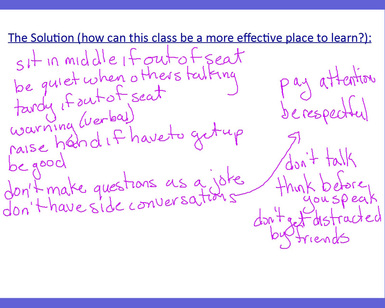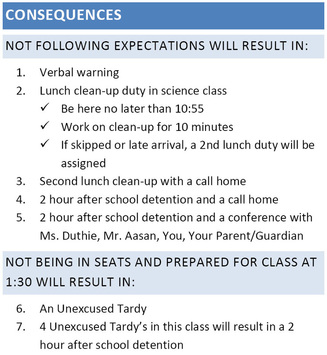Classroom Management Plan
I began my student teaching following a co-teaching model for autumn quarter. When I took over teaching full-time in January, I was having
classroom management issues with one of my periods. Throughout the beginning of the year, this
had been a squirrely group that was a bit on the unruly side, but my
cooperating teacher was able to manage them fairly well. When I took over, this group of students
began to test limits and push boundaries more, and I was unable to manage the
class. Students were not following the
classroom expectations, and were constantly talking over other students,
carrying on side conversations when I was trying to talk with the class, were
not prepared for class with their materials, left without being dismissed, and
during group work times were wandering and talking to other students, and
generally off-task. My cooperating
teacher and I discussed the problem, and came up with the solution of
clarifying classroom expectations and consequences.
I devoted about 45 minutes of a classroom period to having a discussion with students about the problems that were occurring in the classroom, as well as how to solve the problems. I began by explaining to the students that I was seeing some problems in student behaviors in the classroom that were taking away from their classroom learning time, and not allowing them the opportunity to meet the learning goals for the day. Instead of telling them exactly what I saw, I asked if they could come up with a list of problems that we were having as a class. They came up with everything that I was wanting to fix, as well as a few more. The ones that I wanted to focus on were:
· At 1:30, out of seats without being prepared for class
· Wandering and chatting with other groups during lab time
· Side conversations when Ms. Duthie and other classmates are talking
· Leaving before dismissed when final bell rings
After making these goals very clear to the class, I asked what they thought possible solutions could be. They began by listing consequences, and I refined the question to expectations they could hold themselves to. This is what the students came up with:
I devoted about 45 minutes of a classroom period to having a discussion with students about the problems that were occurring in the classroom, as well as how to solve the problems. I began by explaining to the students that I was seeing some problems in student behaviors in the classroom that were taking away from their classroom learning time, and not allowing them the opportunity to meet the learning goals for the day. Instead of telling them exactly what I saw, I asked if they could come up with a list of problems that we were having as a class. They came up with everything that I was wanting to fix, as well as a few more. The ones that I wanted to focus on were:
· At 1:30, out of seats without being prepared for class
· Wandering and chatting with other groups during lab time
· Side conversations when Ms. Duthie and other classmates are talking
· Leaving before dismissed when final bell rings
After making these goals very clear to the class, I asked what they thought possible solutions could be. They began by listing consequences, and I refined the question to expectations they could hold themselves to. This is what the students came up with:
Once these expectations had been laid out, we combined and
narrowed them down to three expectations that were clearly written on the
whiteboard at the front of the room, so students had a reminder of the
plan. These were:
- When someone is talking: pay attention and be respectful.
- When at lab groups, stay at groups and work to accomplish class goals
- Be in seats when class starts at 1:30 by be by them when the bell rings at 2:25
Following this discussion, I found that students had a clear
understanding of how their behavior was affecting both their learning, as well
as their classmates’. Students began to
show more appropriate behaviors, and follow expectations. For students who were not, they were clearly
called out as soon as an inappropriate behavior was shown, and they understood
exactly what had gone wrong and what they needed to change. When assigned lunch duties, the students were
able to understand exactly why they had to spend the first part of their lunch
in my classroom. Students also began
holding each other accountable for behaviors, and when fellow students were not
following the expectations, they would remind each other of the rules and
consequences.
Through these experiences, I have had excellent examples and modeling of how to set up a classroom management plan, as well as how to fix classroom management when it has gone awry. I have learned the importance of making very clear expectations for students, so they know what is expected of them. I also learned that they typically know when they are not following the expectations. In having one period that was not following expectations and creating management issues, I was allowed the opportunity to learn how to fix an issue. As a class, we were able to re-develop a set of classroom norms and expectations, as well as clear consequences for if they were not followed. By being transparent with the students, they knew that I was troubled by their behavior and why, and it seemed that they worked hard to fix the problems. These are methods that I will employ in my classroom to allow students the opportunity to have a safe and productive learning environment.
Through these experiences, I have had excellent examples and modeling of how to set up a classroom management plan, as well as how to fix classroom management when it has gone awry. I have learned the importance of making very clear expectations for students, so they know what is expected of them. I also learned that they typically know when they are not following the expectations. In having one period that was not following expectations and creating management issues, I was allowed the opportunity to learn how to fix an issue. As a class, we were able to re-develop a set of classroom norms and expectations, as well as clear consequences for if they were not followed. By being transparent with the students, they knew that I was troubled by their behavior and why, and it seemed that they worked hard to fix the problems. These are methods that I will employ in my classroom to allow students the opportunity to have a safe and productive learning environment.


